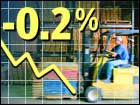
NEW YORK (CNN/Money) -
Producer prices fell in the United States in April, reflecting the biggest drop in food costs in nearly 28 years, the government said Friday.
The Producer Price Index -- a measure of prices paid to factories, farmers and other producers -- fell 0.2 percent after rising 0.1 percent in March, the biggest decline in four months, the Labor Department reported. Economists surveyed by Briefing.com expected prices to rise 0.4 percent.
Excluding often-volatile food and energy prices, the "core" PPI rose 0.1 percent after rising 0.1 percent in March. The latest rise matched expectations of economists surveyed by Briefing.com.
"Overall inflation remains quite benign," Lynn Reaser, chief economist for Banc of America Capital Management, told the Associated Press Friday. "Companies selling to consumers and businesses have limited pricing power."
Prices for clothing and light trucks, including sport/utility vehicles (SUVs), also fell sharply.
U.S. stock prices were mixed in Friday morning trading with the Dow slightly lower and the Nasdaq little changed. Bond prices headed lower after the reports Friday.
Inflation has been relatively tame for some time, especially during a recession in the broader economy that the National Bureau of Economic Research said began in March 2001.
To fight the recession and keep consumers spending, the Federal Reserve cut its target for short-term interest rates 11 times in 2001. The Fed has left rates at low levels so far this year, and some economists earlier in the year thought the central bank would soon have to raise rates to fight inflation.
But consumer prices have been tame, and the productivity of U.S. businesses grew in the first quarter at the fastest rate in nearly 19 years, allowing companies to produce more goods at lower prices.
Economists said there seemed little imminent threat from price pressures and that the report added weight to the view that the Federal Reserve will hang fire for some time before beginning to reverse some of the 11 interest rate cuts it made last year.
"This is a very favorable report," Richard DeKaser, chief economist at National City Corp. in Cleveland, told Reuters. "In the context of what we've seen in the recent past, the Fed is right to say that inflation has been quiescent. It gives them more latitude to forestall an inevitable rate hike,"
Food costs headed lower led by prices for fresh and dry vegetables posted a record decline of 46.5 percent in April, compared with a 22.7 percent jump in March. That offset a 2.5 percent increase in energy prices, helping keep inflation well in check.
The index for crude energy materials jumped 22.4 percent in April, compared with a 15.2 percent increase in March. Natural gas prices rose 39.5 percent, up sharply from a 19.7 percent increase the previous month.
Oil prices surged in April, driven by intensifying violence in the Middle East, a month-long embargo by Iraq, and political turmoil in Venezuela, the world's No. 4 oil exporter.

|

